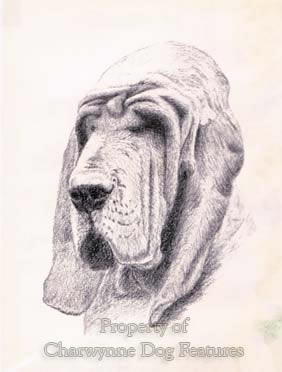147 BORN TO TRACK - THE BLOODHOUND
BORN TO TRACK - Keeping Tabs on the Bloodhound
by David Hancock
 Bloodhounds, and, with their remarkable scenting skill, were born to track. Uniquely amongst recognised breeds of dog, they feature in the show ring, in field trials for tracking and in the hunting field, albeit in a quarry-less hunt. Yet the Bloodhound, with its lugubrious face, sorrowful eyes, disturbing voice and pendulous ears, is never going to be confused with another breed.
Bloodhounds, and, with their remarkable scenting skill, were born to track. Uniquely amongst recognised breeds of dog, they feature in the show ring, in field trials for tracking and in the hunting field, albeit in a quarry-less hunt. Yet the Bloodhound, with its lugubrious face, sorrowful eyes, disturbing voice and pendulous ears, is never going to be confused with another breed.
Writing on the Bloodhound in his Modern Dogs of 1897, Rawdon Lee was more than frank: 'He has been much used as a cross to improve the olfactory organs, the voice, and the size and strength of other hounds, particularly of otter hounds and foxhounds; but he has always had admirers who kept him for his own sake - because of his handsome and noble appearance, and because he was faithful and affectionate. Others encouraged him because he bore a vulgar and undeserved character for ferocity not attained by any other breed of dog.'
I'm glad he mentioned the Bloodhound's olfactory organs, they are arguably its most valuable feature. The great French hound expert, the Comte le Couteulx de Cantelou, who had considerable experience of Bloodhounds hunted as a pack, often on boar, gave a different dimension to the breed: 'No hound is easier to manage, or more obedient, or less likely to change deer...As I have had and reared more than three hundred of these hounds, I can certify that they have a charming nature.'
In his Hounds of the World, Buchanan-Jardine wrote of them: 'I have bred and hunted with my foxhounds a good number of first- and second-cross bloodhounds, and have found that they are of quite a different nature to foxhounds, being much more affectionate to their master, and also showing more intelligence and grasping more quickly what one wants them to do.' But whether possessing an undeserved character for ferocity, a charming nature or being quicker on the uptake than Foxhounds, there is no doubting the individuality of this breed.
Until the Kennel Club's recent change of heart over harmful wording in breed standards, the word picture of the Bloodhound almost encouraged disadvantageous features. Those who claim they were perpetuating the traditional form of the breed should study old prints and paintings. A past breed standard which required such features as loose skin, especially about the head and neck, where it is expected to hang in deep folds, allows even encourages the exaggerators to produce the extreme versions. Because of the large amount of loose skin and heavy folds around the throat and neck, that area in the breed is predisposed to moist dermatitis.
Despite the wording of this standard on eyes, requiring them not to be sunken, far too many in the show ring specimens are exhibited with such a feature. Gough and Thomas, in their 'Breed Predispositions to Disease in Dogs and Cats' (Blackwell, 2004), list this breed as being predisposed to six different eye defects. The requirement for a 'deep keel' is alleged to have made the breed more liable to bloat. The Kennel Club's recently-launched drive to make breeds more 'fit for function' may in time reduce these flaws.
A dispute between the breed clubs and the KC has arisen because of the latter's willingness to register hounds from the packs, which the show breeders claim are crossbreeds. It would be good to think that both parties are seeking a sounder, healthier, more virile, unexaggerated hound, for the good of the breed. Closed gene pools recycle genes both good and bad; sadly closed gene pools are so often accompanied by closed minds too. Show breeders so often stop seeing the dog, only the breed. This can mean that an unsound dog can be rewarded just because it possesses breed type in abundance, not a mistake made by our sporting ancestors who bequeathed such a breed to our care.
A report in The Kennel Gazette of January 1892, reviewing the breed for the previous year, recorded: 'I hope that in constitution the present hounds have undergone some improvement. Breeders have looked to this, and sought further afield for fresh outcrosses. The immediate result was, of course, some loss of character, which, for a time, as far as exhibition purposes were concerned, proved disastrous; now, however, that the elimination of the cross has been carried to the fourth and fifth generations, it has had the desired effect in strengthening the constitution and thereby the resistant power to disease; whilst the character and type have been brought back and retained by the predominance of the old blood. It is astonishing how little of a different blood, will, in a measure at least, protect against the severest forms of disease.' Those words should serve as guidance to modern breeders, who claim to have the best interests of the breed at heart. The greatest Bloodhound breeder of them all, Edwin Brough, recommended an outcross in every fifth generation. For him at least, it was all in the blood. The blood is precious but the anatomy in the show hounds is just as important; these hounds were born to track and can do without quite needless physical handicaps imposed casually and, in many cases, cruelly by unthinking exhibitors. These hounds deserve better!